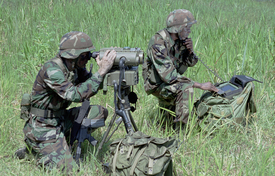
Posted by John Keller
Here's an interesting dilemma: how can people see the spot of light produced by a laser target designator in broad daylight? The answer is they often can't, and that isn't good.
The problem has little, if anything, to do with potential weapons malfunctions. Laser-guided munitions are extremely good at following a laser beam to the target, and have been for nearly decades. The problem is making sure the laser is illuminating the right target.
The U.S. Air Force uses forward-observers on the ground to confirm to combat pilots by radio whether the aircraft are illuminating the correct targets. It can happen that laser designators light up the wrong targets in the confusion of battle and complicated city skylines.
Now consider this: broad daylight can overwhelm even visible laser spots, not to mention eye-safe lasers not visible to the naked eye. When that happens, ground observers can't help the pilots, and that could lead to politically devastating collateral damage, especially if allied munitions hit schools, hospitals, or wedding receptions.
This is a dilemma that the military and the electro-optics industry are coming to grips with right now. Those involved in the electro-optics industry reported at the Photonics West trade show this week that military officials have been contacting them lately with this problem. Although it doesn't look like formal programs are in progress yet, plenty of smart folks are thinking about ways to deal with it.
For some, the solution may simply be an easy modification to night-vision devices that ground observers use. By adding some filtering, these goggles and binoculars might be able to eliminate all light except the wavelength of the laser in use. No sunlight, no reflections, just a nice clean laser spot.
That might not solve the entire problem, however. Some ambient light has to make it through the filter so ground observers can see the target as well as the laser designator spot.
Other people are looking at aircraft-based forward-looking infrared sensors to extend focal plane array sensitivity to a broadening light spectrum to let in just the right amounts of light, and ignore the kinds of light that cause confusion.
Any way they slice it, this is a big problem. It looks like solutions, however, might be on the way.
No comments:
Post a Comment